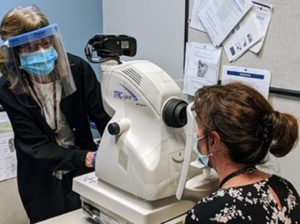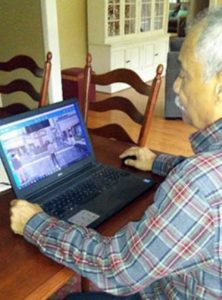DURHAM, NC — Across the country, diabetes patients have faced extraordinary challenges throughout the pandemic.
They disproportionately suffer from acute COVID-19 and experience higher rates of hospitalization and death. Shelter-at-home orders, job losses, and distribution issues made finding adequate, nutritious, and healthy food difficult for many. Closures of hospitals and clinics, deferral of non-essential care, and social isolation reduced support from healthcare professionals and trained caregivers and led to poor disease management. Many healthcare systems struggled to create new options from scratch, leaving patients in the lurch for months.
But not the VA.
Veterans continued to receive care, kept regular appointments with their clinical team, provided updated glucose readings, monitored diabetic foot ulcers and eye complications, received automated medication refills, had access to yoga and cooking programs, and in some cases received necessary food deliveries thanks to the VA’s long-standing commitment to the use of technology. The department couldn’t make COVID-19 less virulent, but it could—and did—reduce the impact the coronavirus had on the lives of veterans with diabetes.
Benefits of Telehealth
The VA has been a national leader in telehealth for more than 20 years, in large part because 25% of veterans live in rural areas. The need to provide care to those who lived at significant distance from VA facilities prompted the department to develop ways to bring care closer. Increasingly, that’s meant into the veteran’s home.
As a consequence, when the pandemic closed many hospitals and clinics to non-COVID-19 care, the VA was well positioned to quickly offer care through alternative means—its robust telehealth services. It took the VA Connecticut Health Care System, for example, just three weeks to transition from seeing nearly all patients in person to conducting 97% of all primary care visits virtually, and at close to the same volume.1
Endocrinologists and other specialists rapidly adopted e-consults and e-referrals and video-to-home visits, particularly for high-risk patients. To maximize the value of those visits, the VA reallocated funds to expand its national loaned tablet program to patients with access issues and delivered other devices for remote patient monitoring, from smartphones to pulse oximeters to foot pads.2
The switch to telehealth put veterans in a better position than many of their neighbors. In a survey by the American Diabetes Association (ADA), 43% of diabetics reported delaying medical care during the pandemic, often because they feared contracting COVID-19. Veterans with diabetes had an option to stay home and receive care, allowing the vast majority to keep their appointments with their primary care teams, nutritionists, and endocrinologists.
Some veterans who needed more structured care improved as a result of telehealth. “While telehealth has proven efficacious for diabetes in research settings, intensive telehealth interventions have rarely been implemented in standard care,” said Elizabeth Kobe, MD candidate at Duke University Medical School. Kobe presented the results of an intensive telehealth intervention at the ADA’s 80th Virtual Scientific Sessions in June 2020.
Using existing VA home telehealth infrastructure and staff, Kobe and her colleagues designed and implemented a six-month telehealth intervention that combined telemonitoring with a module-based self-management support and medication management program. Clinical staff called patients every two weeks for 30 minutes. Patients transmitted their blood glucose measurements daily via home telehealth-issued equipment.
Her study found that participants in the Advanced Comprehensive Diabetes Care (ADCD) program improved their HbA1c by a mean of 1.36 points over six months, dropping to 7.89% and persisting for at least 18 months. While the study began before the pandemic, veterans continued to participate and benefit throughout 2020. “Despite the drastic changes that COVID-19 has forced us to make, ACDC delivery has continued unabated,” Kobe said.
Beyond being able to contact healthcare providers, telehealth enables veterans to learn how to better manage their diabetes and participate in group sessions. In January 2021, the ADA awarded recognition status to the VA and DoD’s Diabetic Self-Management Education (DSME), calling it one of the most engaging and true-to-life virtual medical experiences focused entirely on diabetes self-management.
Veterans access DSME through the VA’s Virtual Medical Center (VMC). Using customizable avatars, veterans navigate the VMC, which looks much like most VA hospitals. Through the avatars, veterans attend any class in the virtual facility, ask diabetes educators questions, and discuss issues with others in their classes.
“At first, the Virtual Medical Center was intimidating, but they have a lot of support staff,” said Orville Bell, a 70-year-old Navy veteran. “I really like it because they keep me focused on how to eat, make good diet decisions. I also like listening to how other people remain disciplined. It’s kind of like being in ‘Diabetes Watchers’ instead of Weight Watchers.’” With encouragement from the program, Bell has lost 30 pounds and dropped his HbA1c from 11 to 6.7.
Connected Devices

The Tomah, WI, VAMC provides telehealth screening to detect eye problems, which is important for patients with diabetes and others. Photo from Sept. 9, 2020, VAntage Point blog
Diabetes can lead to foot ulcers, which account for 80% of non-traumatic amputations in veterans, and to diabetic retinopathy, the most common cause of blindness in American adults. The VA was determined to provide care to limit both of these frequent complications despite the pandemic. To do so, they enlisted the help of technology again.
The Initiative to End Diabetic Limb Loss at VA (TIEDLLV), supplies at-risk, diabetic veterans with Podimetrics Mats, which can detect foot ulcers up to six weeks before they would be identified in an exam, and from the comfort of their home. A veteran stands on the mat once a day and in 20 seconds the device measures the temperature of the feet using thermal imaging and transmits the information Podimetrics’ cloud-based artificial intelligence system. The AI analyzes the data and alerts the provider if there are signs of a developing diabetic foot ulcer.
Early results indicate that the Podimetrics system almost entirely eliminates severe ulcers and reduces ulcer-associated hospitalizations by 92%. “I saw countless Veterans lose their lives because of complications from diabetic foot ulcers,” said Suzanne Shirley, VHA Innovation Ecosystem director of partnerships and community engagement. “I knew we had to tackle this problem and find a solution. Once we saw the results from the use of remote temperature monitoring, we worked to make sure that it became a part of VA’s diabetic care.”
The Tomah VAMC uses teleretinal imaging to detect changes in the eye for veteran with diabetes. A special camera captures images of the lining of the eye which medical staff sent to optometrists to evaluate. The reduction in the number of appointments and travel required for diagnosis and treatment has been particularly valuable with COVID-19 in circulation.
“Providing safe care to our veterans in locations convenient to them leads to regular use of technology and telehealth services,” said Karen Long, Tomah VAMC’s acting director. “We are proudly leveraging our virtual care tools to ensure our patients and staff are as safe as possible.”
- Spelman JF, Brienza R, Walsh RF, Drost P, Schwartz AR, Kravetz JD, Pitkin P, Ruser C. A Model for Rapid Transition to Virtual Care, VA Connecticut Primary Care Response to COVID-19. J Gen Intern Med. 2020 Oct;35(10):3073-3076. doi: 10.1007/s11606-020-06041-4. Epub 2020 Jul 23. PMID: 32705471; PMCID: PMC7377306.
- Heyworth L, Kirsh S, Zulman DM, Ferguson JM, Kizer KW. Expanding Access through Virtual Care: The VA’s Early Experience with COVID-19. NEJM Catalyst: innovations in care delivery. 2020 Jul 1; https://catalyst.nejm.org/doi/full/10.1056/cat.20.0327.
- Kobe EA, et al. Implementation of an intensive telehealth intervention for rural patients with uncontrolled diabetes. Presented at: American Diabetes Association Scientific Sessions; June 12-16, 2020 (virtual meeting).
Cutline: Veteran Orville Bell accesses Diabetic Self-Management Education via VA’s Virtual Medical Center.


